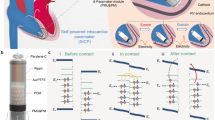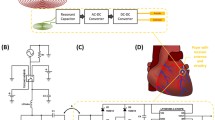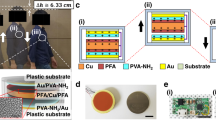Abstract
An automatic power-generating system (AGS) which converts kinetic energy into electric energy for quartz watches was tested as a power source for implantable cardiac pacemakers. An automatic power-generating mechanism and a capacitor (0.33 F) were removed from a quartz watch (SEIKO) and encapsulated in a polyvinyl case. Characteristics of the AGS were investigated by acceleration equipment. The capacitor in the AGS was charged to 2.0 V (0.66 J) by placing it on the equipment for about 30 minutes. The equipment has a 2 Hz cycle and generates ±1.7 G at the end of each half cycle. The AGS (fully charged to 2.0 V) was used as the power source for a pulse generator circuit built using commercially available CMOS IC. The circuit generated pulses of 0.5 ms width at 1 Hz (60 pulses min−1). The voltage of the AGS was maintained at 1.6 V while it was being charged by the accelerations. The generator supplied pulses of 0.75V, 1.47 mA through a 510Ω load. With fully charged AGS, the generator was also used to pace a mongrel dog's heart at 140 beats min−1 for 60 minutes. During pacing, the AGS supplied 420 mJ to the circuit and the cardiac muscle. The AGS was placed on the right ventricular wall of the mongrel dog under anaesthesia. Energy of 80 mJ is stored in a capacitor by the heart beating at about 200 beats/min for 30 minutes. Thus the AGS generated 13 μJ per heart beat. This result suggests that the AGS may supply enough energy for use in a cardiac pacemaker.
Similar content being viewed by others
References
Alt, E., Barold, S. S., andStangl, K. (Eds) (1993): ‘Rate adaptive cardiac pacing’ (Springer-Verlag, Berlin, Heidelberg) pp. 318–331
Crossley, G. H., Gayle, D. D., Simmons, T. W., Haisty, W. K., Bailey, J. R., Davis-O'Brien, K., Hammon, J. W., andFitzgerald, D. M. (1996): ‘Reprogramming pacemakers enhances longevity and is cost-effective’,Circulation,94, pp. 245–247
Greatbatch, W., Holmes, C. F., Takeuchi, E. S., andEbel, S. J. (1996): ‘Lithium/carbon monofluoride (Li/CFx): a new pacemaker battery’,Pacing Clin. Electrophysiol.,19, pp. 1836–1840
Hayakawa, N. (1988): ‘A study of the new energy system for quartz watches (II)—The effective circuit for the system’, Proc. Congrès Européen de Chronométrie, C. E. C., pp. 81–85
Kraus, M., Buckingham, T. A., andCandinas, R. (1997): ‘High thresholds may alter end-of-life behavior in a dual chamber pacemaker’,Pacing Clin. Electrophysiol.,20, pp. 1691–1697
Lanmuller, H., Bijak, M., Mayr, W., Rafolt, D., Sauermann, S., andThoma, H. (1997): ‘Useful applications and limits of battery powered implants in functional electrical stimulations’,Artif. Organs,21, pp. 1210–212
Markewitz, A., Kronski, D., Kammeyer, A., Kaulbach, H., Weinhold, C., Doering, W., andReichart, B. (1995): ‘Determinants of dual chamber pulse generators longevity’,Pacing Clin. Electrophysiol.,18, pp. 2116–2120
Mond, H. G., andStokes, K. B. (1992): ‘The electrode-tissue interface: The revolutionary role of steroid elution’,PACE,15, pp. 95–107
Preston, T. A., andBowers, D. L. (1974): ‘The automatic thresholds tracking pacemaker’,Med. Instrum.,8, pp. 322–325
Schaldach, M., andFurman, S. (Ed.) (1975): ‘Longevity and pacemaker power sources’,in ‘Advances in pacemaker technology’ (Springer-Verlag), Chapter 5
Schuchert, A., andKuck, K. H. (1994): ‘Influence of internal current and pacing current on pacemaker longevity’,Pacing Clin. Electrophysiol.,17,(1), pp. 13–16
Suma, K. (Ed.) (1996): ‘Pacemaker data book’ (Japan Publications)
Toyoshima, T. (1997): ‘Batteries for implantable medical devices’,Clin. Eng.,8, pp. 734–741
Yasukawa, N., andNagao, S. (1986): ‘A study of the new energy system for quartz watches’, Proc. Congrès de Chronométrie, La Chaux-de-Fonds, pp. 15–18
Author information
Authors and Affiliations
Corresponding author
Rights and permissions
About this article
Cite this article
Goto, H., Sugiura, T., Harada, Y. et al. Feasibility of using the automatic generating system for quartz watches as a leadless pacemaker power source. Med. Biol. Eng. Comput. 37, 377–380 (1999). https://doi.org/10.1007/BF02513315
Received:
Accepted:
Issue Date:
DOI: https://doi.org/10.1007/BF02513315




